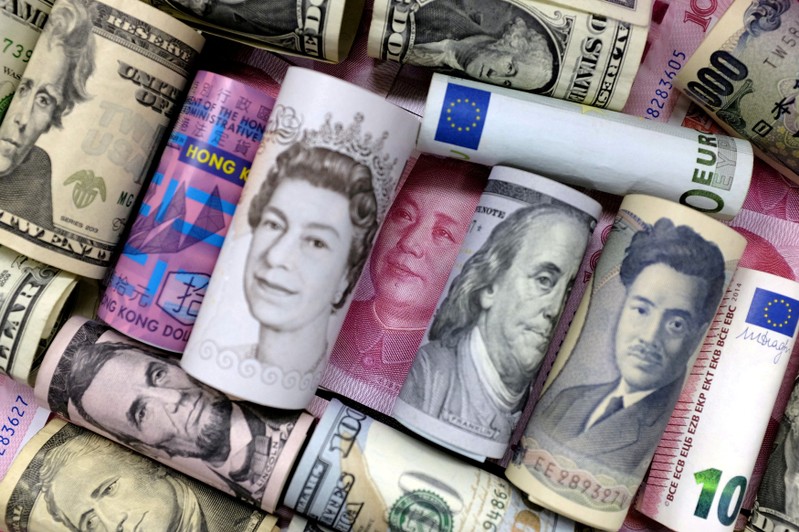
FILE PHOTO: Euro, Hong Kong dollar, U.S. dollar, Japanese yen, British pound and Chinese yuan banknotes are seen in this picture illustration, January 21, 2016. REUTERS/Jason Lee/Illustration/File Photo
September 18, 2019
By Stanley White
TOKYO (Reuters) – The dollar traded near a seven-week high versus the yen on Wednesday as oil markets slowly recovered from a supply shock, but markets were cautious ahead of a U.S. Federal Reserve meeting later in the day that is expected to deliver another interest rate cut.
Sterling traded near a six-week high versus the dollar as some speculators scaled back bearish bets on the pound, but sentiment remained weak due to uncertainty over how Britain will exit the European Union.
With investors largely pricing in a quarter-point rate cut by the Fed, the focus will be on how much more easing it signals for this year and next.
Some analysts warn that the dollar could bounce if the Fed does the minimum that markets expect.
“Speculators are already excessively short the dollar,” said Yukio Ishizuki, foreign exchange strategist at Daiwa Securities in Tokyo.
“If there are no surprises from the Fed, the speculators will have to give up their dollar shorts. The biggest reaction would be in dollar/yen.”
The dollar traded at 108.20 yen <JPY=EBS> on Wednesday, close to a seven-week high of 108.37 yen.
The pound <GBP=D3> was quoted at $1.2487, holding onto a 0.6% gain from Tuesday, when it briefly touched the highest since July 19.
Oil prices edged lower in Asia, extending a 6% tumble on Tuesday after Saudi Arabia’s energy minister said the kingdom has tapped inventories to restore oil supplies to where they stood before drone attacks over the weekend shut around 5% of global oil output.
JUMP IN U.S. BORROWING COSTS
A surge in overnight U.S. borrowing costs also supported the dollar.
Overnight borrowing costs in the $2.2 trillion repurchase agreement market spiked to 10% on Tuesday as lending dwindled due to huge corporate tax payments and the settlement of $78 billion of Treasuries sold last week.
The repo market allows banks and Wall Street dealers use
securities as collateral to obtain cash from money market funds
and other cash investors.
The New York Fed responded by injecting $53.15 billion into the financial system with overnight repos, a money market operation it has not used in more than a decade.
The New York Fed later said in a statement it will conduct another repo operation on Wednesday for up to $75 billion.
The spike in short-term rates shows there is a shortage of dollar liquidity in the U.S. repo market, but some investors and analysts are also worried about a shortage of dollars in the offshore market.
Some traders say are monitoring cross-currency basis swaps <JPYCBS3Y=>, which are starting to widen in a sign of higher costs for dollars.
“This problem will come up again in a week or two because there will be strong demand for dollars at the end of September, which is the end of the third quarter,” said Akira Takei, a global fixed income fund manager at Asset Management One in Tokyo.
“We better prepare for a rainy day. Difficulty in funding dollars could lead to another sell-off in Treasuries.”
The chaotic moves in money markets and late-day swings in U.S. federal funds futures mean the CME’s <FEDWATCH> tool shows about a 51% chance that the Fed will cut rates by 25 basis points on Wednesday, which is at odds with economists’ and market expectations.
Elsewhere in the currency market, the euro stood at $1.1065 <EUR=EBS>, little changed in Asian trade.
The Australian dollar fetched $0.68485 <AUD=D3>, down 0.27%.
The dollar index <.DXY> measuring the greenback against a basket of six major currencies fell 0.03% to 98.288.
After the Fed releases its policy decision, traders will turn to the Bank of Japan’s meeting ending on Thursday to see if it follows its global peers by easing policy.
Deepening negative rates will be the key option if the BOJ were to ease, although the central bank may accompany that with measures to mitigate the pain on financial institutions, sources have told Reuters.
(Editing by Jacqueline Wong & Kim Coghill)

